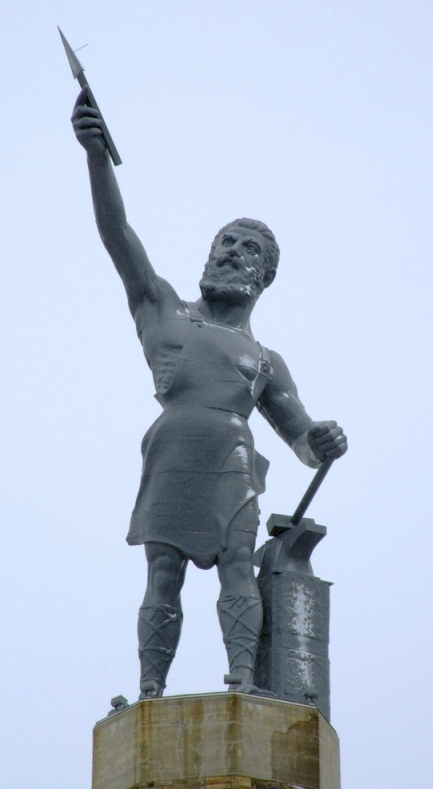 Article Written
Article Written
by John Davis
You’d be excused if you were shocked by the wanderings of a major American monument. What if the Statue of Liberty was hauled out to a carnival, or the St. Louis Arch was made into a giant slingshot? Upsetting, no? Even worse, what if the statues in the rotunda of the Congress were painted with garish bright primary colors? You’d probably want the head of whoever allowed such a travesty.
Now consider Vulcan. He was the Greek God who fell from Mount Olympus. Vulcan landed inside a volcano on a Mediterranean Island where he became the God of the Forge, perpetually banging away on his anvil to create the marvels of metalwork. Birmingham’s promoters thought this myth the perfect representative of their pulsing, industrialized foundry city. The God of the Forge was made visible by the city.
April, 1904, was the beginning date for the Great St. Louis World’s Fair. Every nation and city with a claim on the future of science, industry, and art wanted in on this grand display in Forest Park. Birmingham, Alabama was just such a booming city. Its powerhouse was molten iron. Vast amounts of iron ore were discovered in the 1870s under a ridge in central Alabama. From that came this bustling city from quite literally nothing. A promoter, J.A. MacKnight, backed by Birmingham industrialists who believed in the value of the Fair’s giant commercial opportunity, found a classically trained sculptor, whose name was Giuseppe Moretti.
Moretti might have been extraordinarily talented, but he was also asked to be almost magical. Birmingham’s Commercial Club gave him a Herculean task: Make an almost six story tall iron statue in the next five months. That Moretti did so, in the feverish pace of time specified, and got the whole delivered to the World’s Fair, is the stuff of industrial legend. Foundrymen worked sixty hour weeks. Teams worked round the clock. Upon completion of this magnificent, mighty statue, whose sandaled feet were longer than two men, whose head was disproportionate to the body, (the better to balance the view for an observer below), they would be proud to see how it dominated the Fair’s Palace of Mining and Metallurgy. Visitors marveled at the mammoth anvil under his poised hand, the other reaching out to display a great arrowhead created through his skill. Everyone knew about Vulcan, and so Birmingham, the mighty iron city that sent him.
Time passed. The Fair was over, and Vulcan went home. He was too disproportionately huge to stand in a proposed location in a prominent city park. (Some said his bare bottom scandalized the mothers and their children.) His right arrow arm broke, and was replaced upside down. Finally, the giant of Birmingham was hauled out to the Fairgrounds. Further humiliations took place. Because his left hand had been installed improperly due to poor craftsmanship, he could no longer hold his hammer.
So, companies started to substitute their products. No less than Heinz 57 and an ice cream cone company vied to use this fallen hero as a tawdry platform from which to shill their wares. Not to be outdone, Coca Cola used him as a tout for its drink, and even an overall company used once mighty Vulcan as a gimmick. There seemed no end to the abuse. Disassembled again in the 1920’s, it was later made whole for an horrific paint job. Rouged cheeks, pale painted skin against primary color sandals made the abuse seem unlimited. By the late 1930s, citizens began to take notice.
Finally, the Kiwanis Club and other civic minded groups decided enough was enough. The standard bearer for Birmingham was to be given a proper home. There, on top of Red Mountain, named for the iron ore underneath, you can see Vulcan today. He looks at his city, spread below, and marvels at the wonders wrought by the forge. You can see Vulcan today atop a viewing pillar in a park dedicated to him.
~Article written by John Davis
Read More from John
 John William Davis is a retired US Army counterintelligence officer and linguist. As a linguist, Mr. Davis learned five languages, the better to serve in his counterintelligence jobs during some 14 years overseas. He served in West Germany, Italy, and the Netherlands during the Cold War. There he was active in investigations directed against the Communist espionage services of the Soviet Union and Warsaw Pact. His mission was also to investigate terrorists such as the Red Army Faction in Germany, the Red Brigades in Italy, and the Combatant Communist Cells (in Belgium) among a host of others.
John William Davis is a retired US Army counterintelligence officer and linguist. As a linguist, Mr. Davis learned five languages, the better to serve in his counterintelligence jobs during some 14 years overseas. He served in West Germany, Italy, and the Netherlands during the Cold War. There he was active in investigations directed against the Communist espionage services of the Soviet Union and Warsaw Pact. His mission was also to investigate terrorists such as the Red Army Faction in Germany, the Red Brigades in Italy, and the Combatant Communist Cells (in Belgium) among a host of others.
His work during the Cold War and the bitter aftermath led him to write Rainy Street Stories, ‘Reflections on Secret Wars, Terrorism, and Espionage’ . He wanted to talk about not only the events themselves, but also the moral and human aspects of the secret world as well.

And now recently published in 2018, John continued his writing with Around the Corner: Reflections on American Wars, Violence, Terrorism, and Hope.
Two powerful books worth reading.
Read more about them in the following Six Questions:
Six Questions with John Davis: Author of Rainy Street Stories
Six Questions with John Davis: Author of Around the Corner

You can see it on Google Earth. It’s huge!
Yes indeed Buckeye Bob! In real life it dominates the mountain over Birmingham!